Alfa Romeo Spider
For the Alfa Romeo Spider (916) launched in 1995, see Alfa Romeo GTV and Spider.
For the Alfa Romeo Spider (939) launched in 2006, see Alfa Romeo Brera and Spider.
| Alfa Romeo Spider | |
|---|---|
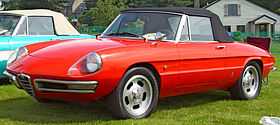 1600 Spider (Duetto) | |
| Overview | |
| Manufacturer | Alfa Romeo |
| Production | 1966–1993 |
| Assembly |
Grugliasco, Turin, Italy[1] San Giorgio Canavese, Italy (Pininfarina) |
| Designer |
Battista Pininfarina Franco Martinengo at Pininfarina[2] |
| Body and chassis | |
| Body style | 2-door roadster |
| Layout | Front-engine, rear-wheel-drive |
| Related |
Alfa Romeo Giulia Alfa Romeo 105/115 Series Coupés |
| Chronology | |
| Predecessor | Alfa Romeo Giulia Spider |
| Successor | Alfa Romeo Spider (1995) |
The Alfa Romeo Spider (105/115 series) is a roadster produced by the Italian manufacturer Alfa Romeo from 1966 to 1993—with small run of 1994 models for the North American market.[3] The Spider remained in production for almost three decades with only minor aesthetic and mechanical changes. The first three series were assembled by Pininfarina in Grugliasco and the fourth series in San Giorgio Canavese. The last Spider was produced in April 1993—the last rear wheel drive Alfa Romeo before the Alfa Romeo 8C Competizione of 2007.
In May 2012, Fiat announced an agreement with Mazda to co-develop a new Spider for 2015 based on the Mazda MX-5 platform.[4] The agreement was finalized in January 2013.[5]
The Spider nameplate originates from the English word "speeder", a two-person open horse-carriage.
History
Series 1 Spider (1966–1969)
| First generation | |
|---|---|
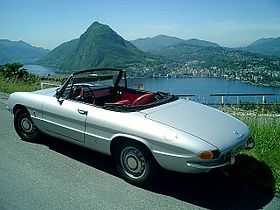 Spider "Osso di seppia" | |
| Overview | |
| Production | 1966–1969 |
| Powertrain | |
| Engine | |
| Transmission | 5-speed manual |
| Dimensions | |
| Wheelbase | 2,250 mm (88.6 in)[6] |
| Length | 4,250 mm (167.3 in) |
| Width | 1,630 mm (64.2 in) |
| Height | 1,295 mm (51.0 in) |
| Kerb weight | 990 kg (2,183 lb) |
The first presentation of the modern car, as a prototype, was at the Turin Motor Show in 1961.[7] However, the continuing success of existing models and the economic challenges facing Italy at the time meant that the first pre-launch production Spiders began to emerge from the Pininfarina production line only at the end of 1965.[7]
Based on the Giulia 105 series chassis, the Spider was launched in the 36th Geneva Motor Show in March 1966.[8] Unnamed at launch, the name "Duetto" was chosen in a write-in competition in Italy.[9] The Italian firm of Pininfarina was responsible for the design of the body; in fact, the Duetto was the last project with which founder Battista "Pinin" Farina was personally associated.[8] Franco Martinengo was the Design Director at Pininfarina at that time.[10] Pininfarina were also responsible for the manufacture of the vehicle's monocoque construction (designed with the relatively new principles of crumple zones incorporated into the front and rear). The engine was a 1570 cc variant of the Alfa Romeo twin cam four cylinder engine, had dual Weber two-barrel side-draft carburetors, and produced 109 hp (81 kW). Sparsely fitted inside but including five speed manual transmission, disc brakes and independent front suspension, the price on launch in Italy was 2,195,000 lire. In the United States the car sold for $3,950 (compared to $3,991 for a Lotus Elan and $2,607 for an MGB).[11] In the United Kingdom the car's price was close to a Jaguar E-Type.[12]
The original "Duetto" was in production from 1966 to 1967; replaced in late 1967 by the 1750 Spider Veloce, powered by a 118 hp (88 kW) 1779 cc engine. In Europe this was fitted with two twin carburettors, whereas models for the North American market (from MY 1969) had SPICA (Società Pompe Iniezione Cassani & Affini) mechanical fuel injection.[13] Modifications were also made to the suspension, brakes, electrics and wheels and tires though the car looked effectively the same. Visible differences were limited to the rear-view mirror repositioned to the door, and different badging on the tail. During the production run, the front repeater lights were moved ahead of the wheelarches. The car's official title was 1750 Spider Veloce, the name "Duetto" being dropped from this point on.
A new Spider 1300 Junior, with a 1290 cc engine producing 89 hp (66 kW), was introduced in 1968. This lacked various features of the 1750, including the plastic headlamp fairings, the brake servo, hubcaps and opening quarterlight. Junior version had black-coloured lower front bumper.
Due to its round (or long) tail, the Series 1 Spider is sometimes known by the nickname of "Osso di seppia" (Italian for cuttlebone) or "boat tail" to differentiate it from the "Kamm tail" Series 2. This particular car was the model featured in the 1967 movie The Graduate, driven by Ben, the character played by Dustin Hoffman.
6,324 of 1600 'Duetto' were made and 2,680 of 1300 Junior.
-
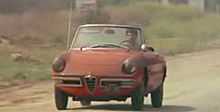
Dustin Hoffman's Spider runs out of gas in The Graduate.
-
Duetto Spider
-

1600 Spider (1965)
Series 2 Spider (1970–1982/83)
| Second generation | |
|---|---|
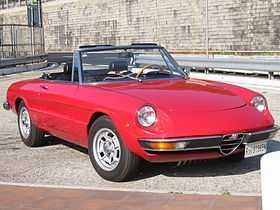 Spider Junior 1.6 (1974) "Coda Tronca" | |
| Overview | |
| Production | 1970–1982 |
| Powertrain | |
| Engine | |
| Transmission | 5-speed manual |
| Dimensions | |
| Wheelbase | 2,250 mm (88.6 in) |
| Length | 4,120 mm (162.2 in) |
| Width | 1,630 mm (64.2 in) |
| Height | 1,290 mm (50.8 in) |
| Kerb weight | 1,025 kg (2,260 lb) |
In 1970 the first significant change to the exterior styling was introduced on the 1750 Spider Veloce, with the original's distinctive elongated round tail changed to a more conventional cut-off tail, called the "Kamm tail", as well as improving the luggage space. Numerous other small changes took place both inside and out, such as a slightly different grille, new doorhandles, a more raked windscreen, top-hinged pedals and improved interior trim.
1971 saw the Spider Veloce get a new, larger powerplant—a 1962 cc, 132 hp (98 kW) unit—and consequently the name was changed from 1750 Spider Veloce to 2000 Spider Veloce. The 1600 Spider restarted production a year later as the Spider 1600 Junior, and was visually identical to the 1300.
1974 saw the introduction of the rare, factory request, Spider-Targa. Based upon the Spider, it featured a Porsche style solid rear window and lift out roof panels, all made out of black GRP type material. Less than 2,000 models of such type were ever made and was the only part solid roof Spider until the introduction of the factory crafted hard top.
The 1300 and 2000 cars were modified in 1974 and 1975 respectively to include two small seats behind the front seats, becoming a "two plus two" four seater. The 1300 model was discontinued in 1977. Also, between 1974 and 1976, the early-style stainless-steel bumpers were discontinued and replaced with black, rubber-clad units to meet increasingly stringent North American crash requirements.
4,557 of 1300 Junior were made and 4,848 of 1600 Junior. 16,320 of 2000 Spider Veloce were made and 22,059 of 2000 Spider Veloce US version. 4,027 1750 Spider Veloce were made.
-
Series 2 Spider 2000 Veloce.
-
Spider Coda Tronca
Series 3 Spider (1982/83–1989/90)
| Third generation | |
|---|---|
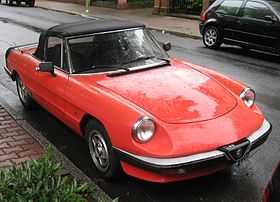 Spider "Aerodinamica" | |
| Overview | |
| Production | 1983–1989 |
| Powertrain | |
| Engine | |
| Transmission | 5-speed manual |
| Dimensions | |
| Wheelbase | 2,250 mm (88.6 in) |
| Length | 4,267 mm (168.0 in) |
| Width | 1,630 mm (64.2 in) |
| Height | 1,290 mm (50.8 in) |
| Kerb weight | 1,040 kg (2,293 lb) |
The Series 3 Spider was previewed in North America for the 1982 model year with the introduction of 2.0 liter Bosch electronic fuel injection to replace the SPICA mechanical injection.
The Spider underwent a major styling revamp in 1983, which saw the introduction of black rubber front and rear bumpers. The front bumper incorporated the grille and a small soft rubber spoiler was added to the trunk lid. The change altered the exterior appearance of the car considerably and was not universally praised by enthusiasts. Various other minor mechanical and aesthetic modifications were also made, and the 1600 car (never available in North America) dropped the "Junior" name.
The Quadrifoglio Verde (Green Fourleaf Clover) model was introduced in 1986, with many aesthetic tweaks, including sideskirts, mirrors, new front and rear spoilers, hard rubber trunk mounted spoilers with integral 3rd stoplight, unique 15" alloys and optional removable hardtop. Different interior trim included blood red carpets and gray leather seats with red stitching. QV was offered in only 3 colours: red, silver and black. It was otherwise mechanically identical to the standard Spider Veloce model, with a 1962 cc double overhead cam, four-cylinder engine (twin two-barrel carburetors in Europe; North American models retained the Bosch L-Jetronic fuel injection introduced for the 1982 model year except that the VVT mechanism was now L-Jet activated) and five-speed manual transmission.[15]
The interior was revised with a new center console, lower dash panels (to meet U.S. regulations) and a single monopod gauge cluster (with electronic gauges). For the North American market a model dubbed the Graduate was added in tribute to the car's famous appearance in the 1967 film, The Graduate, starring Dustin Hoffman.
The Graduate was intended as a less expensive "entry-level" Alfa. While it had the same engine and transmission as the Quadrifoglio and Veloce, it lacked the alloy wheels and luxury features of the other two models. The Graduate model had manual windows, basic vinyl seats, a vinyl top, and steel wheels as standard. Air conditioning and a dealer-installed radio were the only options. It first appeared in 1985 in North America and continued until 1990.
Minor changes occurred from 1986 to 89, including new paint colors, a center high mount stop lamp (CHMSL) midway through 1986 for North American models, a move away from the fade-prone brown carpet and new turn signal levers. Some 1988 models featured automatic seatbelts that extended from a large device between the front seats.
-
Spider Veloce (North America).
-
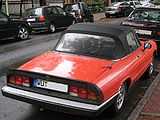
Spider 3rd series.
-
Spider 3rd series Quadrifoglio Verde version with optional hard top.
Series 4 Spider (1990/91–1993)
| Fourth generation | |
|---|---|
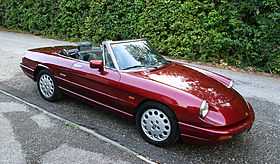 Spider "Type 4" in the rare "Vinaccia Red". | |
| Overview | |
| Production | 1990–1993 |
| Powertrain | |
| Engine | |
| Transmission |
5-speed manual 3-speed automatic |
| Dimensions | |
| Wheelbase | 2,250 mm (88.6 in) |
| Length | 4,257 mm (167.6 in) |
| Width | 1,630 mm (64.2 in) |
| Height | 1,262 mm (49.7 in) |
| Kerb weight | 1,110 kg (2,447 lb) |
The final major change to the Spider came in 1990. The primary mechanical change was that the Spider was given Bosch Motronic electronic fuel injection with an electric fan.[15] Externally, the Spider lost its front under-bumper spoiler and the rear trunk-lid spoiler and picked up 164-style rear lights stretching across the width of the car as well as plastic bumpers the same color as the car. This also marked the first generation of this car with automatic transmission.
In North America, the styling changes did not appear until the 1991 model year; 1990 models featured the Motronic fuel injection but retained the black bumpers. Power steering, larger knee bolsters and a driver-side airbag also appeared as standard for North American market Spiders, which were available in two configurations: Spider and Spider Veloce. Primary differences were in standard equipment: the Veloce substituted leather seats for the base model's vinyl; 15" alloy wheels were one size up from the standard steel wheels with hubcaps; and air conditioning and a cloth top were standard.
Production of the original Spider ended in 1993. An all-new Alfa Spider arrived one year later.
A limited edition Spider Commemorative Edition was produced for the North American market in 1993 and was badged as a 1994 model. Each of the 190 Spider CEs imported to the United States had a small plaque affixed to the dashboard that identified which of the 190 cars it was.[3] The CEs differed from previous Spiders in that they had a special badge on the nose, a "CE" script badge below the "Spider Veloce" badge on the tail, unique gold center caps on the "phonedial" 15" wheels, and burl wood interior trim. Each model came with a leather portfolio, numbered keychain, and documentation. The cars followed the VIN sequence 008276 to 008460, although there does not appear to be any systematic order numbering. It appears that all of the 1994 Spider Commemorative Editions were produced in May 1993.
In Europe this version was also sold with 1.6 L engine used in series 3, it was fitted with Weber 40DCOM4/5 carburettors.[16]
-

Spider 4th series side profile.
-
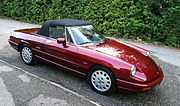
Spider 4th series top closed.
-
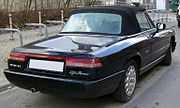
Spider 4th series showing the new rear end.
Production
| Year | Units made |
|---|---|
| 1970 | 2,539 |
| 1971 | 3,735 |
| 1972 | 4,121 |
| 1973 | 4,848 |
| 1974 | 5,107 |
| 1975 | 5,189 |
| 1976 | 4,338 |
| 1977 | 4,183 |
| 1978 | 3,868 |
| 1979 | 4,129 |
| 1980 | 5,584 |
| 1981 | 1,653 |
| 1982 | 1,923 |
| 1983 | 5,365 |
| 1984 | 6,587 |
| 1985 | 5,590 |
| 1986 | 7,215 |
| 1987 | 4,339 |
| 1988 | 4,090 |
| 1989 | 3,950 |
| 1990 | 7,106 |
| 1991 | 9,073 |
| 1992 | 3,640 |
| 1993 | 1,956 |
| 1994 | 11,190 |
| Total | 110,128 |
Total production 1966–1993: 124,104 cars.
Generations
| Model | Engine | Power | Torque | Years | Production |
|---|---|---|---|---|---|
| Series 1: Duetto, Osso di Seppia or Roundtail | |||||
| Duetto | 1,570 cc | 109 PS (80 kW; 108 hp) | 142 N·m (105 lb·ft) | 1966–1967 | 6,324 |
| 1750 Veloce | 1,779 cc | 118 PS (87 kW; 116 hp) | 168 N·m (124 lb·ft) | 1967–1969 | 4,674 |
| 1750 Veloce US version | 1,779 cc | 132 PS (97 kW; 130 hp) | 168 N·m (124 lb·ft) | 1969 | a |
| 1300 Junior | 1,290 cc | 89 PS (65 kW; 88 hp) | — | 1968–1969 | 2,680 |
| Series 1 total production: | 13,678 | ||||
| Series 2: Fastback, Coda Tronca or Kamm tail | |||||
| 1750 Veloce | 1,779 cc | 124 PS (91 kW; 122 hp) | 168 N·m (124 lb·ft) | 1970–1973 | 4,027 |
| 1300 Junior | 1,290 cc | 104 PS (76 kW; 103 hp) | 137 N·m (101 lb·ft) | 1970–1977 | 4,557 |
| 2000 Veloce | 1,962 cc | 133 PS (98 kW; 131 hp) | — | 1971–1982 | 38,379b |
| 1600 Junior | 1,570 cc | 110 PS (81 kW; 108 hp) | — | 1972–1981 | 4,848 |
| Series 2 total production: | 51,811 | ||||
| Series 3: Aerodinamica or Duck Tail | |||||
| 2000 | 1,962 cc | 128 PS (94 kW; 126 hp) | 178 N·m (131 lb·ft) | 1982–1989 | 29,210c |
| 1600 | 1,570 cc | 104 PS (76 kW; 103 hp) | 142 N·m (105 lb·ft) | 1983–1989 | 5,400 |
| Quadrifoglio Verde | 1,962 cc | 132 PS (97 kW; 130 hp) | — | 1985–1989 | 2,598 |
| Series 3 total production: | 37,208 | ||||
| Series 4: Ultima | |||||
| 2000 | 1,962 cc | 126 PS (93 kW; 124 hp) | 166 N·m (122 lb·ft) | 1990–1993 | 18,456 |
| 1600 | 1,570 cc | 109 PS (80 kW; 108 hp) | — | 1990–1992 | 2,951 |
| Series 4 total production: | 21,407 | ||||
Notes
- ↑ "Spider 1600 Duetto". hem.passagen.se. Archived from the original on 21 February 2008. Retrieved 2008-01-23.
- ↑ "Designer". ajovalo.net. Retrieved 2012-02-08.
- ↑ 3.0 3.1 "Affordable Classic: 1991-94 Alfa Romeo Spider 2000". sportscarmarket.com. Archived from the original on 27 June 2007. Retrieved 2007-06-22.
- ↑ "Fiat and Mazda announce co-operation program" (PDF). fiatspa.com. 2012. Retrieved 2012-05-23.
- ↑ "Alfa Romeo, Mazda confirm roadster project". Retrieved 2012-01-18.
- ↑ "1966 Alfa Romeo 1600 Spider Duetto". carfolio.com. Retrieved 2007-10-27.
- ↑ 7.0 7.1 "Used Car Test: 1968 Alfa Romeo 1750 Spider". Autocar. 136. (nbr 3967): pages 22–23. 27 April 1972.
- ↑ 8.0 8.1 "History 1960-1970". alfaromeo.com.au. Archived from the original on 2007-02-19. Retrieved 2007-06-22.
- ↑ "1967 Alfa Romeo Duetto". conceptcarz.com. Retrieved 2007-06-22.
- ↑ "Design director". tom-tjaarda.net. Retrieved 2012-02-09.
- ↑ http://www.nadaguides.com
- ↑ The Encyclopedia of Classic Cars 1945–1975
- ↑ "Affordable Classic: 1971-81 Alfa Romeo Spider". .sportscarmarket.com. Archived from the original on 9 June 2007. Retrieved 2007-06-22.
- ↑ Willson, Quentin (1995). The Ultimate Classic Car Book. DK Publishing, Inc. ISBN 0-7894-0159-2.
- ↑ 15.0 15.1 "Affordable Classic: 1991-94 Alfa Romeo Spider 2000". ..sportscarmarket.com. Archived from the original on 27 June 2007. Retrieved 2007-06-22.
- ↑ Jim Talbott & Stuart Taylor. "Series 4 Spider" (PDF). aroc-uk.com. Archived (PDF) from the original on 24 July 2011. Retrieved 2011-06-20.
- ↑ "Produzione complessiva" (PDF). pininfarina.it. Archived from the original (PDF) on 2011-06-05. Retrieved 2007-08-03.
Bibliography
- Holmes, Mark (2007). Ultimate Convertibles: Roofless Beauty. London: Kandour. pp. 10–11. ISBN 9781905741625.
External links
| Wikimedia Commons has media related to Alfa Romeo Spider "Duetto". |
- Alfa Romeo Spider register
- Alfa Romeo Spider at the Internet Movie Cars Database
| « previous — Alfa Romeo Automobiles S.p.A., a subsidiary of Fiat S.p.A. since 1986, car timeline, 1950s–1970s — next » | ||||||||||||||||||||||||||||||||
|---|---|---|---|---|---|---|---|---|---|---|---|---|---|---|---|---|---|---|---|---|---|---|---|---|---|---|---|---|---|---|---|---|
| Type | 1950s | 1960s | 1970s | |||||||||||||||||||||||||||||
| 0 | 1 | 2 | 3 | 4 | 5 | 6 | 7 | 8 | 9 | 0 | 1 | 2 | 3 | 4 | 5 | 6 | 7 | 8 | 9 | 0 | 1 | 2 | 3 | 4 | 5 | 6 | 7 | 8 | 9 | |||
| Small family car | Dauphine | Alfasud | ||||||||||||||||||||||||||||||
| Compact executive car | Giulietta (750/101) | |||||||||||||||||||||||||||||||
| Giulia | Giulietta (116) | |||||||||||||||||||||||||||||||
| Executive car | 1750 Berlina | Alfetta | ||||||||||||||||||||||||||||||
| 2000 Berlina | Alfetta 2000 | |||||||||||||||||||||||||||||||
| 1900 | 2000 | 2600 | Alfa 6 | |||||||||||||||||||||||||||||
| Coupé | Giulietta Sprint | GT Junior | Alfasud Sprint | |||||||||||||||||||||||||||||
| Giulia Sprint GT/1750 GTV/2000 GTV | Alfetta GT and GTV | |||||||||||||||||||||||||||||||
| 1900 Sprint | 2000 Sprint | 2600 Sprint | ||||||||||||||||||||||||||||||
| Cabriolet | 1900 | Giulia GTC | ||||||||||||||||||||||||||||||
| Spider | Giulietta Spider | Giulia Spider | Spider | |||||||||||||||||||||||||||||
| 2000 Spider | 2600 Spider | |||||||||||||||||||||||||||||||
| Roadster | Gran Sport Quattroruote | |||||||||||||||||||||||||||||||
| Sports car | 6C 2500 | Montreal | ||||||||||||||||||||||||||||||
| 33 Stradale | ||||||||||||||||||||||||||||||||
| Racing car | TZ | GTA | ||||||||||||||||||||||||||||||
| 158/159 | Tipo 33 | 177 | ||||||||||||||||||||||||||||||
| Off-road | Matta | |||||||||||||||||||||||||||||||
| LCV | Romeo | Romeo 2 | Romeo 3 | F11/F12/A11/A12 | ||||||||||||||||||||||||||||
| AR8 | ||||||||||||||||||||||||||||||||
| « previous — Alfa Romeo Automobiles S.p.A., a subsidiary of Fiat S.p.A. since 1986, car timeline, 1980s–present | ||||||||||||||||||||||||||||||||||||
|---|---|---|---|---|---|---|---|---|---|---|---|---|---|---|---|---|---|---|---|---|---|---|---|---|---|---|---|---|---|---|---|---|---|---|---|---|
| Type | 1980s | 1990s | 2000s | 2010s | ||||||||||||||||||||||||||||||||
| 0 | 1 | 2 | 3 | 4 | 5 | 6 | 7 | 8 | 9 | 0 | 1 | 2 | 3 | 4 | 5 | 6 | 7 | 8 | 9 | 0 | 1 | 2 | 3 | 4 | 5 | 6 | 7 | 8 | 9 | 0 | 1 | 2 | 3 | 4 | 5 | |
| Supermini | MiTo | |||||||||||||||||||||||||||||||||||
| Small family car | Arna | 145 | ||||||||||||||||||||||||||||||||||
| Alfasud | 33 | 146 | 147 | Giulietta (940) | ||||||||||||||||||||||||||||||||
| Compact executive car | Giulietta (116) | 75/Milano | 155 | 156 | 159 | |||||||||||||||||||||||||||||||
| Executive car | Alfetta | 90 | 164 | 166 | ||||||||||||||||||||||||||||||||
| Alfa 6 | ||||||||||||||||||||||||||||||||||||
| Coupé | Sprint | GT | ||||||||||||||||||||||||||||||||||
| GTV and GTV6 | GTV (916) | Brera | ||||||||||||||||||||||||||||||||||
| Spider | Spider (105/115) | Spider (916) | Spider (939) | |||||||||||||||||||||||||||||||||
| Sports car | SZ | RZ | 8C Competizione | 4C | ||||||||||||||||||||||||||||||||
| 8C Spider | 4C Spider | |||||||||||||||||||||||||||||||||||
| Racing car | 179/182/183T/184T/185T | 155 V6 TI | ||||||||||||||||||||||||||||||||||
| LCV | F11/F12/A11/A12 | AR6 | ||||||||||||||||||||||||||||||||||
| AR8 | ||||||||||||||||||||||||||||||||||||





